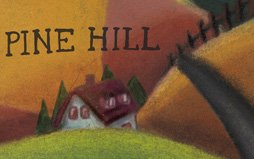| Return to Home
A Brief History of Pine Hill -
For Current Info: http://www.pinehill-in-the-catskills.com/  The Indians knew Pine Hill as Kawiensinck. This was told to the interpreter Thomas Nottingham by two Esopus Indians, John Paulin and Sapan. It was placed on a map as such for the Hardenburgh Patent in 1771 by William Cockburn. The Indians knew Pine Hill as Kawiensinck. This was told to the interpreter Thomas Nottingham by two Esopus Indians, John Paulin and Sapan. It was placed on a map as such for the Hardenburgh Patent in 1771 by William Cockburn.
About 1740, Henry Bush, a guide from Shokan, led Robert Livingston and his son Robert R. Livingston, along the Esopus, over Pine Hill and on to the East Branch of the Delaware River where Margaretville now stands. A rough road that would be later called the Ulster and Delaware Turnpike was hacked out of this wilderness to the settlement of Pakatakan. Aaron Adams made the first clearing in Pine Hill before 1800 and built what is presumably the small upper portion on the present Colonial Inn.
In 1831, a Frenchman, Augustus A. Guigou built the first tannery in the Town of Shandaken. It was located behind the hotel we knew as the Funcrest. It was destroyed by fire in 1858 and never rebuilt.
Stagecoach service began about 1853-54, making regular trips from Kingston to Pine Hill. Without any mishap, the trip would take seven hours. There were three stops in our area; the farm house at the foot of Rose Mountain, now the Kennedy residence; the Colonial Inn in Pine Hill, and the Moran residence on the other side of Highmount. This was also the beginning of the tourist trade.
The mountain people used to say they would never be able to put a train over the rugged Pine Hill, but they did and in 1872 the Ulster and Delaware Railroad reached Pine Hill and with it a booming tourist trade. The Horseshoe Curve, sometimes frightened passengers when they were told the engineer could shake hands with the man in the caboose as they traveled around it, but it also gave them a magnificent view of the serene little village in the valley below.
From the beginning Pine Hill was noted for its clean air and pure water. It was called the ‘Saratoga of the Catskills’. This brings us to the Crystal Spring Water Company, a company that started operating about 1885 and employed twenty hands. The pure spring water was bottled and six to nine carloads per week were shipped, via the railroad, to New York City.
The early 1900’s saw a bottling operation, but instead of water they were bottling soda pop.
In February 1933 an explosion caused the fateful fire that destroyed the huge buildings and brought an end to the Crystal Spring industry and nearly to the fire department, as fourteen firemen were overcome with toxic gasses. However, it is still supplying Pine Hill with its pure water today.
Pine Hill was quite widely known as a big resort area. In the early 1800’s clergymen made it their summer headquarters, attracting professors, students and summer tourist. It was considered a health spa because of the fresh mountain air and pure spring water. There were well over twenty hotels and boarding houses in the area, including the Guigou House, rip Van Winkle, Alpine, Cornish house, Avon Inn, The Ulster, to mention a few of the larger ones.
In the early 1900’s the Pine Hill Lake was built and later lost in the flood of ’51. The Pine Hill Arms built the Air Drome, one of the first ‘silent movie’ theatres around, which was lost in a storm.
The Colonial Inn put in a rope tow to service the slope behind the hotel, and although it was small by today’s standards, it started the winter trade in our area.
Pine Hill became an incorporated village in 1885. Its population was around 600, and there were among other things, 2 bowling alleys, 2 newspapers, 2 churches, 3 or 4 turning mills, several stores, a funeral parlor, a livery and a photo shop. The Fire Department was founded in 1897.
|
